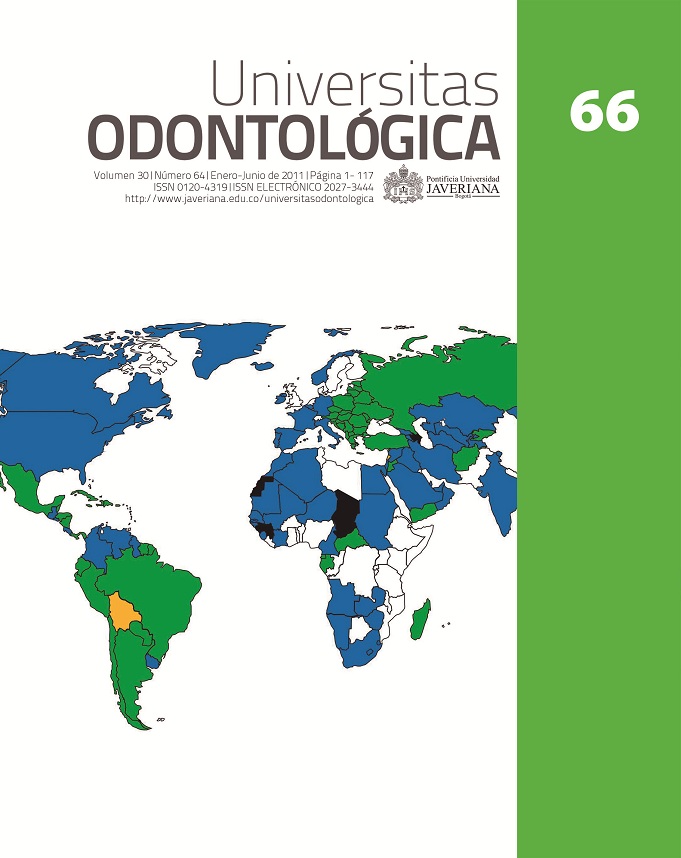Abstract
Objetivo: determinar la frecuencia de las lesiones orales que se presentaron en los pacientes con VIH/sida que asistieron a la Unidad de Infectología del Hospital Universitario San Ignacio en Bogotá, Colombia, en el periodo 2005-2010. Métodos: se realizó un estudio observacional descriptivo con una muestra de 180 de un total de 1600 historias clínicas. Los criterios de inclusión fueron historias clínicas de pacientes con VIH/sida mayores de 18 años de edad. Se excluyeron las historias clínicas de pacientes que no presentaban los resultados del conteo de linfocitos T CD4+. Los hallazgos se analizaron descriptivamente por medio de distribuciones de frecuencia y promedios. Resultados: la frecuencia general de lesiones orales fue del 47,8 %. La lesión oral más frecuente fue la candidiasis seudomembranosa (12,8 %), seguida por leucoplasia vellosa (5 %) y herpes simple (4,4 %). En el análisis la presencia de lesiones orales se asoció un conteo promedio de linfocitos T CD4+ de 135 células/mm3. Conclusiones: las lesiones orales más frecuentes fueron candidiasis oral seudomembranosa, leucoplasia vellosa y herpes simple. La disminución de células T CD4+ se asocia con la aparición de lesiones orales.
Objective: To determine the frequency of mouth diseases in HIV/aids patients attending the Infectious Disease Unit of the San Ignacio University Hospital in Bogota, Colombia, during 2005-2010. Methods: A descriptive study with a sample of 180 out of 1600 clinical records was carried out. Criterion for inclusion in the study was patients 18 years of age. Records without T-lymphocyte (CD4) count were excluded. Data were analyzed descriptively through frequency distribution and averages measures. Results: Mouth diseases were reported in 47.8 % of the records. The most common lesion was pseudomembranous candidiasis (12.8 %), followed by hairy leukoplakia (5 %) and herpes simplex (4.4 %). Mouth diseases were associated with an average CD4 count of 135/mm3. Conclusion: Oral pseudomembranous candidiasis, hairy leukoplakia and herpes simplex were the most frequent disease. A decrease in CD4 cell count is associated with mouth diseases.
This journal is registered under a Creative Commons Attribution 4.0 International Public License. Thus, this work may be reproduced, distributed, and publicly shared in digital format, as long as the names of the authors and Pontificia Universidad Javeriana are acknowledged. Others are allowed to quote, adapt, transform, auto-archive, republish, and create based on this material, for any purpose (even commercial ones), provided the authorship is duly acknowledged, a link to the original work is provided, and it is specified if changes have been made. Pontificia Universidad Javeriana does not hold the rights of published works and the authors are solely responsible for the contents of their works; they keep the moral, intellectual, privacy, and publicity rights.
Approving the intervention of the work (review, copy-editing, translation, layout) and the following outreach, are granted through an use license and not through an assignment of rights. This means the journal and Pontificia Universidad Javeriana cannot be held responsible for any ethical malpractice by the authors. As a consequence of the protection granted by the use license, the journal is not required to publish recantations or modify information already published, unless the errata stems from the editorial management process. Publishing contents in this journal does not generate royalties for contributors.


